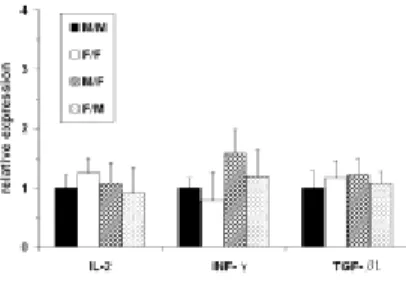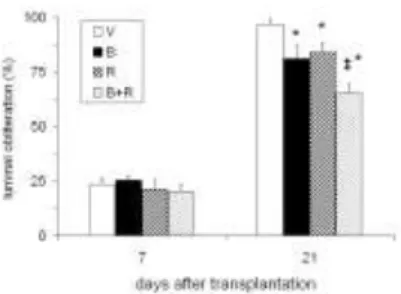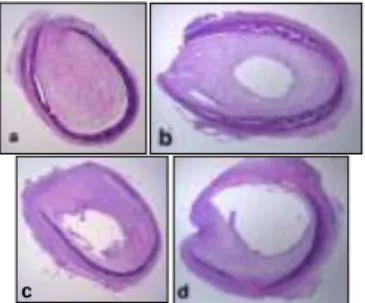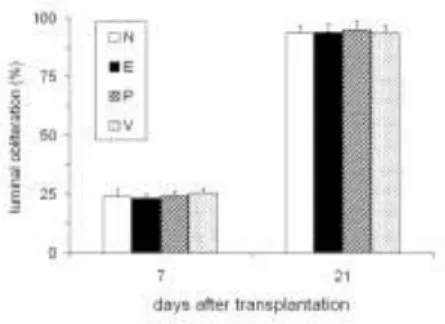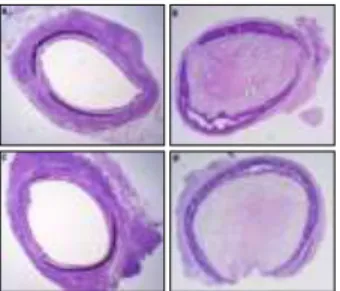Investigation of bronchiolitis obliterans in a rat tracheal transplantation model
Doctoral Theses János Fillinger
Semmelweis University PhD School of Clinical Medicine
Supervisor: Balázs Antus MD, Ph.D
Opponents: Veronika Müller MD, Ph.D Zsuzsanna Csoma MD, Ph.D
Head of doctoral committee: Péter Nagy MD, DSc Members of doctoral committee: Judit Pápay MD, Ph.D
Károly Simon, MD, Ph.D
Budapest 2011
1. Introduction
Many respiratory disease leads to end-stage lung disease. For such patients - after carefully selecting the appropriate patient – lung transplantation is the only chance to live a quality life, and in many cases to survive. Thanks to the development of surgical techniques, new immunosuppressive drugs and more effective implementation of peri-and post-operative care the number of successful lung transplantations has increased significantly.
Previously, the prevention of acute rejection of the transplanted organ was the greatest challenge in lung transplantation. According to the data from large transplant centres the introduction of modern immunosuppressive drugs significantly suppressed the frequency of life- threatening acute rejections. However, contrary to expectations, more effective immune suppression only slightly influenced the long-term survival of transplants. Today, the most common cause for the late loss of transplanted lung is chronic obliterative bronchiolitis (OB) that leads to chronic dysfunction of the transplanted lung. Currently, neither the pathophysiology nor an effective treatment of the disorder is known.
Follow-up studies over the last decade shed light to the fact that in the case of some kind of transplanted parenchymal organs gender differences between the donor and recipient are of great importance for the outcome of transplantation and/or the rejection of allografts.
In addition to gender differences many other factors may also play a role in the development of BOS. In addition to its haemodynamic effects, angiotensin II, the main effector peptide of the renin-angiotensin system (RAS), has a fibroproliferation inducing activity in several organs as well.
Similarly, beside its vasoconstrictor effect, endothelin (ET)-1 has a profibrotic and growth-inducing effect in many tissues. There are several
observations suggesting a central role for these two molecules in the chronic rejections of heart and renal transplantations.
Low molecular weight heparins (LMWH) that is mixture of glycosaminoglycan molecules of different chain lengths are widely used for prophylaxis and treatment of thromboembolic diseases. Experimental results demonstrated that the immunosuppressive and antiproliferative effects of heparin are independent of its anticoagulant activity.
2. Objectives
Our research had focused on analyzing how donor and recipient gender influences the development of obliterative airway disease (OAD) in rat trachea allografts In addition we had investigated if the addition of angiotensin-converting enzyme (ACE) inhibitors, ET receptor blockers and LMWH derivatives can reduce the progression of OAD in this animal model. This dissertation presents a series of three experiments that were aimed to test the following hypotheses:
a. The donor and recipient gender influence the development of OAD in rat tracheal allografts.
b. The use of ACE inhibitors and ET-1 receptor antagonists together the graft occlusion rate is better suppressed as compared to inhibiting the RAS and the ET system separately.
c. LMWH therapy reduces the development of OAD in rat tracheal allografts as manifested by a decline of leukocyte infiltration around the graft and a reduced rate of fibroproliferation.
3. Methods
3.1. Animals
In our experiments, inbred male and female Lewis (Lew, RT1; WOBE Ltd., Budapest, Hungary), and male and female Brown Norway (BN, RT1;
WOBE Ltd.) rats weighing 250-300g were used. The experiments were conducted in compliance with the relevant animal protection laws and were approved by the Ethics Committee.
3.2. Transplantations
Tracheas of BN rats were heterotopicly transplanted in the Lew rats. Briefly, donor animals were anaesthetized by pentobarbital (Nembutal, 80 mg/kg ip., Egis, Budapest, Hungary) and the trachea was taken from the animals. The recipient Lew rats were subjected to a longitudinal incision on their neck, a subcutaneous "pocket" was formed over the muscles and the trachea grafts were placed into this pocket. No immunosuppressive therapy was given.
3.3. First experimental group of animals
The 96 animals involved in the study were randomly assigned to four groups based on the gender of the donor and the recipient as follows: male donor/male recipient (M/M), male donor/female recipient (M/F), female donor/male recipient (F/M) and female donor/female recipient (F/F). After implantation, the animals were harvested on day 7, 14 and 21, respectively.
3.4. Second experimental group of animals
In this set of experiment 64 Lewis recipients were randomly divided into four experimental groups (n=16 animals/group) based on treatment administered. The animals received either one of the following: dual ET receptor (ETA and ETB) antagonist bosentan (B; 100mg/kg, Tracleer®,
Actelion Ltd., Allschwil, Switzerland ), ACE inhibitor ramipril (R, 5mg/kg, Tritace®, Sanofi Aventis, Budapest, Hungary), or a combination of the above two drugs (B+R; for doses see above), or vehiculum (V). Animals were treated from day 0 to the day of harvesting. The drugs were administered daily to the animals by the means of oral gastric tube (1 ml solution/animal). From each group 8 animals were harvested on day 7, while the remaining eight animals were harvested on day 21.
3.5. Third experimental group of animals
The 64 animals were randomly divided into 4 groups (n=16 animals/group).
The first group of animals were treated with nadroparin (N, 57 anti-Xa IU/kg; Fraxiparine®, GlaxoSmithKline, Budapest, Hungary), the second with enoxaparin (E, 100 anti-Xa IU/kg; Clexane®, Sanofi Aventis, Budapest, Hungary), the third group with parnaparin (Fri, 91 anti-Xa IU/kg;
Fluxum®, Alpha Wassermann, Budapest, Hungary), while the fourth group with vehiculum (V) only by subcutaneous injection. Nadroparin was given once daily, while enoxaparin and parnaparin was administered twice daily. 8 animals from each group were sacrificed on day 7, while the remaining, 8 animals were killed on day 21.
3.6. Histological evaluation
For histology, tracheal grafts were fixed in buffered formalin (4%), embedded in paraffin and stained with hematoxylin-eosin (HE) solution.
Sections were utilized for computerized morphometry (Olympus DP-Soft) to calculate the percentage of the luminal obliteration and the epithelial loss.
3.7. Molecular analysis
Total RNA from the tracheal grafts was extracted with TRI-Reagent (Sigma, Sigma-Aldrich Ltd, Hungary). cDNA was synthesized with the TaqMan
Reverse Transcription Reagents Kit (Applied Biosystems, Applera Ltd, Budapest, Hungary). Specific cDNA products corresponding to mRNA for PDGF-A chain, TGF- 1, IL-2, INF- and MCP-1 were amplified using real- time PCR with the TaqMan Universal PCR Master Mix Kit (Applied Biosystems). The relative level of mRNA expression of a specific gene was calculated based on CT method (BIORAD) and normalized to mRNA level for the housekeeping gene such as glyceraldehydes-3-phosphate dehydrogenase (GAPDH).
3.8. Statistical analysis
Results are reported as mean ± standard error of the mean (SEM). Data were compared using analysis of variance (ANOVA) followed by multiple pair- wise comparison according to the Newman-Keuls test. Calculations were performed by GraphPad Prism 4.0 (GraphPad Software Inc., San Diego, CA, USA). Differences were considered statistically significant at p<0.05.
4. Results
4.1. First set of experiments
In tracheal allografts removed on day 21, the lumens were almost completely blocked by scar tissue, regardless of the gender of either the donor or the recipient (M/M: 93.6±3.9, M/F: 94.1±4.1, F/F: 96.2±3.1 and F/M: 95.9±4.1%; p> 0.05) (Figure 1).
The luminal obstruction was accompanied by a complete destruction of the epithelium Although the rate of occlusion on days 7 and 14 was smaller than on day 21, there was no apparent gender difference (Day 7: M/M: 28.2 ± 2.4, M/F: 26.0 ± 3.1, F/F: 25.4 ± 0.7, F/M: 22.9 ± 2.8%; p> 0.05; Day 14: M/M: 67.9 ± 11.2, M/F: 61.9 ± 16.8, F/F: 66.2 ± 10.9, F/M: 63.1 ± 6.6%, p> 0.05). Similarly, the extent of damage to the
epithelium (epithelial necrosis) did not differ between the groups of animals (Figure 2).
Figure 1. Luminal obliteration in rat tracheal allografts on day 7, 14 and 21.
Figure 2. Epithelial necrosis in the trachea allografts on day 7, 14 and 21.
Figure 3. Cytokine and growth factor expression in trachea allografts on day 21 following transplantation.
The expression of IL-2, INF-γ and TGF-β1 cytokine in allografts removed on day 21 was analyzed by real-time PCR. In accordance with the histological results, there was no significant difference between the groups for any mRNA examined (Figure 3).
4.2. Second set of experiments
In trachea grafts removed on day 7 the obliterative process has already begun but no difference between the groups were apparent. In animals treated with vehiculum, the graft lumen was virtually completely filled with scar tissue. In animals treated with bosentan (B) the luminal obliteration was significantly reduced compared to animals receiving vehiculum only (A) (B:
81.0±6.1 vs. A: 96.6±2.4%, p <0.05). To nearly the same extent ramipril treatment (R) also reduced luminal obliteration (R: 83.9±4.3%, p <0.05). In animals receiving combination therapy (B+R) the extent of obliteration was even lower than in animals receiving bosentan or ramipril treatment alone (B+R: 65.3±4.1%, p <0.01) (Figure 4).
Figure 4. Luminal obliteration in trachea grafts on day 7 and 21. *p<0.05 and
#p<0.01 vs. vehicle treatment
In tracheal grafts removed on day 7 approximately 20% of the total airway epithelium was destroyed (Figure 5). The remaining cells lost their
surface cilia and were flattened. The animals treated together with bosentan and ramipril (B+R) exhibited less epithelial necrosis, but the difference was not statistically significant (p>0.05).
Figure 5. Epithelial necrosis in tracheal allograft on day 7 and 21. *p<0.05 vs. vehicle treatment
c
Figure 6. Rat trachea histological section on day 21 of vehiculum (a), bosentan (b), ramipril (c) and ramipril + bosentan, (d)-treated allografts (HE staining, magnification
4).
In animals treated with vehiculum the epithelium of grafts removed on day 21 was fully necrotized and the lumens were filled scar tissue entirely. Inflammatory cells could only be seen on the scar. In animals treated with bosentan or ramipril alone similar levels of damage to the epithelium was seen. By contrast, in animals receiving combination therapy
(B+R) epithelial necrosis decreased slightly, but significantly (B+R:
87.9±4.9 vs. V: 100%, p<0.01) (Figure 5 and 6).
Figure 7. Cytokine and growth factor mRNA in trachea allografts 21 days after transplantation. *p<0.05 vs. vehiculum-treated animals, #p<0.05 vs. bosentan- or ramipril-treated animals
On day 21 expression of the intragraft TGF- 1 and PDGF-A (as assessed by real-time PCR) was directly proportional to the luminal obliteration of individual animal groups. Both bosentan (B) and ramipril treatment (R) reduced TGF- 1 and PDGF-A expression as compared to vehiculum treatment (V) (p<0.05) (Figure 7). With combined therapy (B+R), the mRNA level for growth factor PDGF-A decreased further (p<0.05), while TGF- 1 levels did not differ significantly as compared to monotherapy.
4.3. Third set of experiment
The recipients’ body weight at the time of transplantation was nearly identical and the animals gained weight at the same rate during the experiment. The animals tolerated the drugs, bleeding complications were not observed.
The process of allograft lumen obstruction had already begun by day 7. The degree of obstruction did not differ significantly between groups (N: 24.0±2.8, E: 23.0±1.6, P: 24.2±1.7 and V: 25.6±1.7%; p>0.05) (Figure 8). On day 21 nearly full obstruction was seen in each of the allografts regardless of treatment (N: 93.5±2.9, E: 93.8±3.5, P: 95.0±3.9, V:
94.2±2.3%; p>0.05) (Figure 8).
Figure 8. Obliteration of the allograft’s lumina in rat trachea on days 7 and 21 in nadroparin (N), enoxaparin (E), parnaparin (P) or vehiculum (V)-treated animals
Transplanted grafts removed on Day 7 exhibited an epithelial surface lesion of nearly 20%. Beneath the mucosal surface and in the graft’s wall abundant lymphocyte and macrophage infiltration could be seen.
LMWH treatment did not affect the extent of epithelial damage (N:
22.1±6.2, E: 24.2±3.4, P: 21.7±2.9, V: 23.5±4.6%, p>0.05). On day 21 full damage of the surface epithelium and necrosis was observed. The infiltration of inflammatory cells was less intense than on day 7. The treatment did not affect the process of epithelium damage, just as was seen for lumen blockage (Figure 9).
Figure 9. Cross-sectional image of vehiculum (V)-treated trachea allograft on day 7 (A) and 21 (B) and image of enoxaparin (E)-treated allografts on day 7 (C) and 21 (D) (HE staining, magnification 4).
On day 21 intragraft expression of cytokines (IL-2, INF- ) growth factors (TGF- 1 and PDGF-A) and chemokines (MCP-1) was similar in each group, independent of treatment (data not shown).
5. Discussion
5.1. First set of experiments
In this study, male and female rats were used as recipients and donors.
Neither the donor’s nor the recipient's gender had an effect on the development of OAD in trachea allografts, despite the fact that there are clear gender differences in the regulation of the immune response and the levels of sex hormones.
The discrepancies between experimental results can be explained in part by the organ-specific effects of sex hormones. For example, in the kidney sex hormones exert their effects on kidney allograft function through renal haemodynamics. In addition, immunological differences between animal models may account for the observed differences. In the rat tracheal transplant model we used, a strong rejection reaction occurs between the
donor and the recipient. The reason for this strong immune response is the total mismatch in MHC class II antigens between the two animal strains.
This may obscure the weak hormonal effects. In other combination strains, where the only difference is in the minor antigens (e.g. Fisher-Lew rat model), the rejection reaction is much milder, so any hormonal effects may be more detectable.
5.2. Second set of experiments
In the second series of experiments, we showed that (1) the ET receptor antagonist bosentan and the ACE inhibitor ramipril reduces to the same extent the progression of OAD in rat tracheal allografts; (2) the obliterative process is even less pronounced with combined application of bosentan and ramipril, and (3 ) the reduced obliteration is accompanied by lower intragraft expression of growth factors TGF- 1 and PDGF-A.
The mechanism of the effect of angiotensin II and ET-1 on the process of obliteration is unclear. Similarly, the mechanism of the additive effect is also unknown. Our results suggest that these molecules exert their effect through different pathogenetic pathways. On one hand, it is conceivable that angiotensin II and ET-1 directly affect the cells involved in the process fibroproliferation. This is supported by the observation that ET-1 has a strong mitotic effect on airway smooth muscle cells and induces fibronectin production in bronchial epithelial cells. ET-1 also promotes differentiation of fibroblasts into contractile myofibroblasts. On the other hand, angiotensin II and ET-1 in the airways may play a role in the biosynthesis of different profibrotic cytokines and growth factors and/or in the regulation of their secretion. Among these mediators TGF- 1 and PDGF appears to be the most important. TGF- 1 is a central mediator of tissue fibrosis, promotes extracellular matrix synthesis and inhibits its metabolism.
5.3. Third set of experiment
In the third experiment we examined the impact of LMWH preparations used in clinical practice on the rejection of tracheal allografts. Three commercially available LMWH preparations were tested: nadroparin, enoxaparin and parnaparin. We have not detected any effect of these preparations on the development of OAD.
Several studies have verified that LMWH preparations - independent of their anticoagulant activity - also have antiproliferative and immunosuppressive effects. In the animal model used in our experiments the formation of intraluminal obliteration is accompanied by an overexpression of several cytokines, chemokines and growth factors such as TGF- 1, PDGF and MCP-1. PDGF has a strong mitogenic effect on smooth muscle cells and fibroblasts, whereas TGF- 1 is considered to be a central mediator of fibroproliferation that takes during transplant rejection. LMWH treatment did not affect the expression of these molecules, consistent with our histological observations. The results demonstrate that LMWH therapy is not suitable for slowing the development of OAD, neither does it affect the long-term survival of tracheal allografts nor the long term outcome of transplantation.
6. Conclusions
From our experiments the following conclusions can be made:
a. Neither the donor’s nor the recipient's gender affect the development of OAD in rat tracheal allografts. Our results do not support the hypothesis that during allocation of donor lungs, gender differences should be considered in clinical practice.
b. ET-receptor blockers and ACE inhibitors reduce the development of OAD in trachea allografts by the same amount. A combination of the
two drugs has a better therapeutic effect. This additive effect likely occurs in an indirect way, through decreased intragraft expression of growth factors TGF- 1 and PDGF-A. In the future these drugs could be considered to complement the immunosuppressive therapy of lung transplant patients to prevent the development of BOS.
c. LMWH treatment has no significant effect on the rejection of tracheal allografts. LMWH did not influence intragraft expression of growth factors including TGF- 1 and PDGF-A, Th1-type cytokines and other chemokines.
Acknowledgements
In relation to my post doctoral work, first and foremost I express my gratitude to my supervisor, Balazs Antus MD for giving me the opportunity to carry out this scientific project at the Department of Pathophysiology. I am thankful for his professional supervision of my work and for the critical remarks during the writing of scientific papers. I also would like to thank him and Imre Barta for their assistance during the process of writing my dissertation. In the molecular studies Attila Sebe MD was helpful for me.
I thank the Head of the Department of Pathology, Ibolya Soltesz MD, who has allowed me to do research, parallel to the daily routine work. I am also grateful to Professor Janos Strausz, the Head of our Institute who has supported me during my work.
Last but not least I would like to thank Eszter Csiszér MD, chief consultant, who directed my attention toward lung transplantation, educated me showing leadership and professional appreciation for demanding work.
Thanks are due to the assistants of the Departments of Pathology and Pathophysiology for the help in animal care and in making histological sections that were indispensable throughout the project.
Publications related to the subject
1. Antus B, Fillinger J, Csiszér E, Czebe K, Horváth I. (2005) Bronchiolitis obliterans szindróma a tüdőtranszplantáción átesett betegekben. Orv Hetil, 146: 953-958.
2. Antus B, Fillinger J, Soltész I, Horváth I. (2005) A bronchiolitis obliterans modellezése patkányokban. Med Thor, 58: 8-13.
3. Antus B, Fillinger J, Sebe A, Jeney C, Soltesz I, Horvath I. (2006) No gender difference in development of obliterative airway disease in rat tracheal allografts. Exp Mol Pathol, 81: 235-238.
4. Antus B, Sebe A, Fillinger J, Jeney C, Horvath I. (2006) Effects of blockade of the renin-angiotensin and endothelin systems on experimental bronchiolitis obliterans. J Heart Lung Transplant, 25:
1324-1329.
5. Antus B, Fillinger J, Sebe A, Jeney C, Horvath I. (2008) Late treatment with angiotensin-converting enzyme inhibitors plus endothelin receptor antagonists ameliorates rat tracheal allograft rejection. Transpl Int, 21: 801-807.
6. Fillinger J, Antus B. (2010) Low-molecular-weight heparins do not modify obliterative airway disease in rat tracheal allografts. Exp Lung Res, 36: 625-631.
Abstracts related to the subject
1. Antus B, Fillinger J, Soltész I, Horváth I. (2004) Az endothelin receptor blokkoló bosentan hatása az obliteratív légúti betegség kialakulására patkány trachea allograftokban. Magyar Transzplantációs Társaság VI. Kongresszusa, Szeged
2. Antus B, Fillinger J, Soltesz I, HorvathI. (2005) No gender difference in the development of obliterative airway disease in rat tracheal allografts. Eur Respir J, 26: 176s.
3. Antus B, Fillinger J, Soltesz I, HorvathI. (2005) A nem szerepe az obliteratív légúti betegség kialakulásában patkány trachea allograftokban. Magyar Transzplantációs Társaság VII. Kongresszusa, Eger
4. Antus B, Fillinger J, Sebe A, Soltész I, Jeney C, Horváth I. (2006) Befolyásolja-e a donor vagy a recipiens neme patkány trachea allograftok kilökődését? Med Thor, 58: 45s.
5. Antus B, Fillinger J, Sebe A, Jeney C, Horvath I. (2007) Role of ischemia in development of obliterative airway disease in rat tracheal allografts. 5th ERS Lung Science Conference, Taormina, Italy
6. Antus B, Fillinger J, Sebe A, Jeney C, Horvath I. (2007) Effect of blockade of the renin-angiotensin and endothelin systems on rat tracheal allograft rejection. Eur Respir J, 30: 518s.
7. Antus B, Fillinger J, Sebe A, Jeney C, Horváth I. (2008) A renin- angiotenzin és az endothelin rendszer szerepe patkány trachea allograftok kilökődésében. Magyar Tüdőgyógyász Társaság 55.
Nagygyűlése, Balatonfüred
8. Antus B, Fillinger J, Sebe A, Jeney C, Horváth I. (2008) A renin- angiotenzin és az endothelin rendszer szerepe patkány trachea allograftok kilökődésében. Magyar Transzplantációs Társaság X.
Kongresszusa, Gyula
9. Fillinger J, Antus B. (2009) Effect of low molecular weight heparins on the development of obliterative airway disease in the rat tracheal transplant model. Eur Respir J, 34: 387s.
10. Fillinger J, Antus B. (2009) Alacsony molekulasúlyú heparinok (LMWH) hatása a kislégúti obstructio kifejlődésére patkány trachea
transzplantációs modellben. Magyar Transzplantációs Társaság XI.
Kongresszusa, Galyatető
11. Fillinger J, Antus B. (2010) Alacsony molekulasúlyú heparinok (LMWH) hatása a kislégúti obstrukció kifejlődésére patkány trachea transzplantációs modellben. Magyar Tüdőgyógyász Társaság 56.
Nagygyűlése, Sopron
